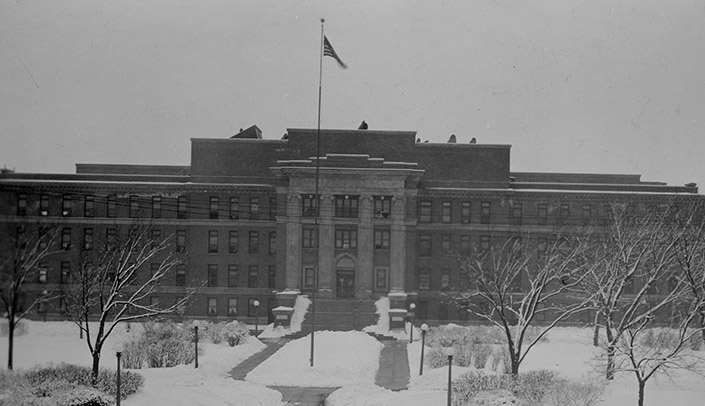In October of 1918, a devastating influenza pandemic made its way from the east coast to Omaha. In response, the University of Nebraska College of Medicine published a three-page informational bulletin to calm a panicked public.
The bulletin provided a concise explanation of the influenza’s spread across Europe and into the United States, beginning at the U.S. Naval Hospital in Chelsea, Massachusetts. In 1918 the attributed cause of influenza was a “small rod-shaped germ, or perhaps a combination of this rod-shaped germ with one or two different kinds of globular-shaped germs.”
In mid-October, the Omaha City Health Commissioner E.T. Manning, M.D., created a commission of doctors from the College of Medicine and Creighton University. Dr. Manning tasked the commission to engage in scientific research regarding the cause of influenza and how to suppress its spread.
Medical personnel understood that direct contact, like kissing or shaking hands, and indirect contact, like using communal cups, spread influenza. They recognized that coughing and sneezing spewed disease-transmitting droplets. The bulletin confidently stated, “The individual who coughs or sneezes carelessly without using a handkerchief is criminally negligent.”
Crowds were also a problem, and on Oct. 4, Dr. Manning banned all Omaha gatherings. Schools, churches and movie theaters were closed. Events such as dances, lodge and labor union meetings were canceled. State prohibitions against spitting in public and the use of common drinking cups were strictly enforced. Streetcars kept windows open for ventilation, and the downtown stores changed their hours in an effort to reduce the number of shoppers in streetcars at any time.
For prevention, the bulletin advised Omahans to apply liquid paraffin or white Vaseline in each nostril 2-3 times daily. The sterile, oily preparations were thought to preserve the natural protective covering of the mucous membrane. For those afflicted with the virus, bed rest and whiskey were considered effective treatments.
According to the Omaha World Herald, W.O. Bridges, M.D., head of the year-old University Hospital, which had just opened in 1917, recognized the use of medicinal whiskey.
“I consider it very valuable,” he stated. “It has no direct action on the disease itself but is a powerful stimulant for the patient.”
Charles W.M. Poynter, M.D., acting dean of the college of medicine, stated, “We have a supply of whisky [sic] and members of the hospital staff will use their judgement [sic] regarding its use. It will be given only on prescription.” Whiskey was on war rationing, but officials released confiscated barrels to hospitals for therapeutic uses.
In 1918, influenza spread across the world. Medical personnel, then as now, did their best to understand the disease and slow its spread.
For more information about the 1918 influenza pandemic in Nebraska, read Kristin Watkins’ dissertation “It Came Across the Plains: the 1918 Influenza Pandemic in Rural Nebraska.”

Excellent reading! Thank you for posting.
I was wondering about the 1918 Omaha experience. Thanks for posting!